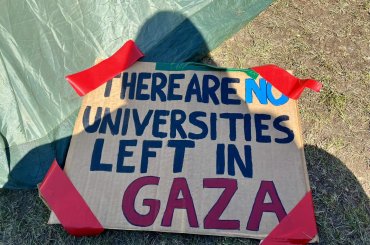One of the most powerful scenes in Jason K. Stearns’s outstanding new book about the Great War in central Africa takes place in eastern Congo, where the violence was the most horrible. Stearns makes his way to the village of Kasika, the site of a June 2000 massacre of more than 1000 people; no Western journalist had been there for a decade. He has no trouble finding Patrice, a handyman and catechist at the church, and other witnesses to the killings. He lets Patrice and the others speak, with pain and eloquence.
There have already been other excellent books about the terrible war that broke out in 1996, and in which the astounding number of as many as 5 million people have already died. Capable experts like Gerard Prunier, Filip Reyntjens and Rene Lemarchand have made sense of an extraordinarily complex conflict, in which at its peak the armies of 9 different nations and another 20 rebel groups fought, which was complicated even further when former allies fell out and turned their weapons on each other.
But Stearns’s Dancing in the Glory of Monsters is the first to use lengthy interviews with participants to bring the awful conflict more fully alive. In so doing, he fulfills his aim – to show that the conflict had a logic behind it, however warped, instead of resorting to shopworn Orientalist explanations like ‘the heart of darkness’ or ‘ancient tribal enmities.’
If there is a weakness in this remarkable work, it is that Stearns does not give enough emphasis to the reckless, irresponsible role of the United States and the West at the beginning of the Great War. Nor does he examine how some Western journalists, blinded by black and white thinking, ignored the atrocities committed by one side.
The killers in the Congolese village of Kasika were Rwandans, of Tutsi background – the same people who had been the victims in the 1994 genocide. Their leader, Paul Kagame, had been lionized in the West, by both the Clinton administration and by some journalists, chiefly Philip Gourevitch. So when in 1996 Rwanda launched an invasion of Congo aimed partly at toppling the long-standing dictator, Mobutu Sese Seko, the West was certainly encouraging Kagame, and the Rwandan army’s atrocities did not get scrutinized.
Stearns does not turn around and transform the Rwandans into the villains. His great strength is that he calmly shows how many factors had created a flammable region: the collapse of Mobutu’s state (Congo’s national income in 1996 had dropped to half the level only 6 years earlier); the presence of millions of unemployed young men; desperate struggles over land; and vast amounts of weapons (Africans point out, ‘aside from South Africa, we have no arms industry on our continent, but somehow we have plenty of automatic rifles’).
Stearns recognizes that the Kagame regime faced a genuine problem in the middle ‘90s; the refugee camps just across the border in Congo included not just Hutu displaced civilians, but tens of thousands of armed genocidaires, who were already staging raids back into Rwanda and threatening to finish off the surviving Tutsi.
But when Kagame’s army attacked westward, they did not only target the Hutu armed killers. Stearns carefully documents massacres they committed in Kasika and elsewhere, of women and children. Even so, in much of the West, Kagame did not lose his halo; as late as 2009 the New Yorker ran another hagiographic article about him by Gourevitch.
Stearns describes brilliantly how Mobutu’s corrupt army collapsed, and within months Rwanda’s choice to succeed him, Laurent Kabila, had come to power in Kinshasa. But then Kabila and Kagame fell out; other countries like Angola and Zimbabwe marched in, and the war’s second and larger phase exploded.
Only about 2 percent of the 5 million deaths actually happened in combat. Stearns is particularly effective at showing how the various armies – “bands of armed looters” might be a better phrase for most of them – crossed the rainforest landscape, generating millions of refugees, who died mainly from hunger and disease.
Stearns does not hide the horrors; if anything, his witnesses make the killings, tortures and rapes much more alive than mere statistics. But because he has so effectively shown the context, the horrors start to become comprehensible – no big surprise, for instance, to anyone who knows the history of Europe in the 20th century. Stearns also uses the comparison of the 30 Years War in 17th century central Europe; after marauding armies swept back and forth, by one estimate a third of the population of Germany had died.
He points out that the Congo’s mineral wealth paid for – and prolonged – the second phase of the Great War. Neighboring countries plundered Congolese cobalt, diamonds, copper, gold, and coltan (used in cellphones). He even has an interview with Pierre Olivier, a Congolese pilot, who describes ferrying planeloads of minerals eastward, to Kagame’s Rwanda. By 2002, a stalemate on the battlefield prompted a ceasefire, although some fighting continues to this day.
The world continues to steal Congo’s minerals; Stearns reports that big companies signed contracts with Congo’s fragile government in 2004-05 that amounted to a “fire sale of assets” that “went against all principles of best practice in international mining.” He adds, “Big mining companies have signed contracts that provide little revenue to the state and have allegedly provided large kickbacks to government officials.”
Jason Stearns should be proud of himself. He points out that the Great War in Africa has gotten relatively little coverage, even in the better newspapers: “The New York Times, one of the few newspapers with extensive foreign coverage, gave Darfur nearly four times the coverage it gave the Congo in 2006, when Congolese were dying of war-related causes at nearly ten times the rate of those in Darfur.” Thanks to Stearns’s decade of hard work, our shameful ignorance is now lessened.

